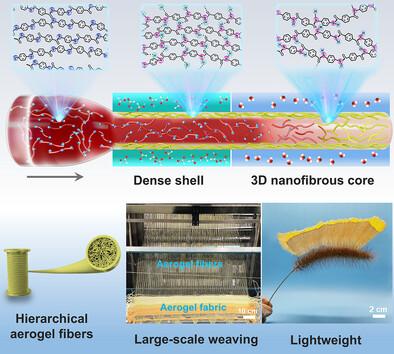Engineering Aramid Aerogel Fibers with Core-Shell Structure for High-Performance Thermal Protective Textiles
IF 19
1区 材料科学
Q1 CHEMISTRY, MULTIDISCIPLINARY
引用次数: 0
Abstract
Overcoming the trade-off between thermal protection and mechanical strength in aerogel fibers represents a significant challenge. To address this, it has structurally engineered aramid aerogel fibers (SEAAFs) with a hierarchical core-shell structure through a two-step coagulation treatment in wet-spinning. The treatment involves the rapid gelation of aramid nanofiber (ANF) spinning sol precursor in acid, forming a rigid and highly ordered shell, followed by a slower gelation process in water, which results in an amorphous and porous core. This structural design enhances the mechanical robustness and preserves high porosity of SEAAFs, properties that can be further optimized by adjusting key spinning parameters, including the type and concentration of acid used, as well as the ANF precursor concentration. Upon optimization, SEAAFs achieve a high stress at break of up to 64.3 MPa and an ultralow thermal conductivity of 28.3 mW m−1 K−1. The excellent mechanical property then enables the successful fabrication of a SEAAF fabric demo with a dimension of 1 × 0.2 m (l × w) on an automatic rapier loom. Moreover, the 0.8 mm-thick aerogel fabric demonstrates excellent thermal insulation performance, comparable to significantly thicker conventional insulating materials under both high temperature (200 °C) and low temperature (−15 °C) conditions.

高性能热防护纺织品用核壳结构工程芳纶气凝胶纤维
克服气凝胶纤维的热保护和机械强度之间的权衡是一个重大的挑战。为了解决这个问题,该公司通过湿纺两步混凝处理,在结构上设计了具有分层核壳结构的芳纶气凝胶纤维(SEAAFs)。处理过程包括芳纶纳米纤维(ANF)纺丝溶胶前驱体在酸中快速凝胶化,形成刚性和高度有序的外壳,然后在水中进行较慢的凝胶化过程,形成无定形和多孔的核心。这种结构设计增强了seaaf的机械坚固性,并保持了其高孔隙率,通过调整关键纺丝参数,包括所用酸的类型和浓度,以及ANF前驱体浓度,可以进一步优化其性能。经过优化,SEAAFs的断裂应力高达64.3 MPa,导热系数为28.3 mW m−1 K−1。优异的机械性能使得在自动剑杆织机上成功制造了尺寸为1 × 0.2 m (1 × w)的SEAAF织物样品。此外,0.8 mm厚的气凝胶织物在高温(200°C)和低温(- 15°C)条件下都表现出优异的保温性能,与较厚的传统保温材料相当。
本文章由计算机程序翻译,如有差异,请以英文原文为准。
求助全文
约1分钟内获得全文
求助全文
来源期刊

Advanced Functional Materials
工程技术-材料科学:综合
CiteScore
29.50
自引率
4.20%
发文量
2086
审稿时长
2.1 months
期刊介绍:
Firmly established as a top-tier materials science journal, Advanced Functional Materials reports breakthrough research in all aspects of materials science, including nanotechnology, chemistry, physics, and biology every week.
Advanced Functional Materials is known for its rapid and fair peer review, quality content, and high impact, making it the first choice of the international materials science community.
 求助内容:
求助内容: 应助结果提醒方式:
应助结果提醒方式:


